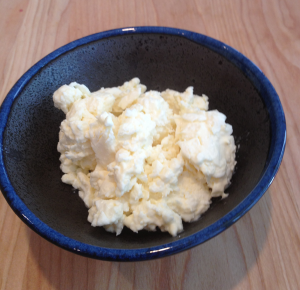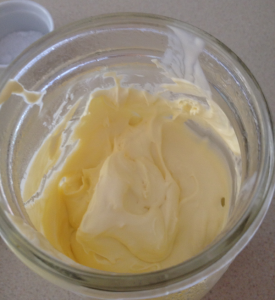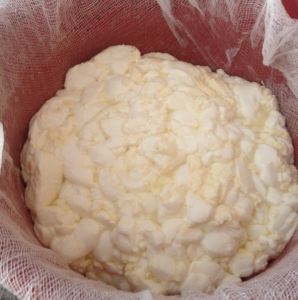
Home Made Cottage Cheese. Made by me!
A few weeks ago I started making cheese using the book Artisan Cheese Making at Home: Techniques & Recipes for Mastering World-Class Cheeses. The book goes from easy to hard and does suggest taking some time to work with the easy recipes before trying the harder ones. So as much as I want to make mozzarella cheese, I’m taking its advice and going slowly, building up my cheese making skills as I go.
I do want to challenge myself though and while the fresh cheeses are easy, they aren’t that interesting taste wise. There is nothing there to really add flavor other than the already great taste of grass-fed milk and salt. So I decided to make a cottage cheese. Cottage cheese is still a fresh cheese that is drained, but utilizes a culture for flavor and rennet for curdling.
Making cheese requires attention to detail, including time. I have to make sure I follow the recipe exactly. Not doing so would probably result in a disaster that pretty much has to be thrown out. So I’m nervous about embarking on this.
The recipe I used in the book also calls for crème fraîche, which is basically a soured cream. So in reality I was making two milk recipes rather than just one.
I’m trying to make a cheese every few weeks. One of the reasons for that is I want to get one cheese made, then figure out the next cheese and order what I need. This might be a mold, or a particular culture as well as the milk and other ingredients. For this particular cheese, I needed to purchase milk and cream as well as a culture and a curd slicer (I ended up buying a long pastry icing knife).
The first thing I needed to do was to make the crème fraîche. In many ways its very similar to making yogurt. I brought the cream up to temperature in a water bath, then sprinkled the small amount of culture on top, allowing it to re-hydrate before whisking it in. Unfortunately it was such a small amount of culture that it sat in a clump on top of the creme and I’m not sure it whisked in properly. After that I just poured it into my yogurt maker overnight. However, I checked it just before going to bed because I was worried that the culture hadn’t hydrated. It didn’t look like it was doing anything, so I stirred some yogurt into it. (According to some web sites, yogurt works well as a culture for crème fraîche).
When I got up the next morning, the mixture looked thicker, but wasn’t sour enough. So I just poured it into a quart mason jar, covered it and left it on the counter for 24 hours. After that it smelled sour enough and I popped it into the refrigerator. But I worried that it was too sour. (see all the worrying I’m doing?)

Crème fraîche - Thick and nicely soured
Next I started in on the cottage cheese. In reality it was fairly easy, the hardest part was the waiting and the wondering if I messed it up. Just starting to make cheese, I’m realizing how easy it is to simply second guess yourself.
I brought the milk up to temperature (70 degrees) in a water bath, then hydrated the culture on it. Whisked the culture in and then whisked in the liquid rennet. Then it was out of the water bath to sit on the stove at room temperature for 5-7 hours. I set my timer for 6 hours figuring that was a good compromise. Don’t get me wrong, I got a lot done around my house in 5 hours (including a batch of the Disney Strawberry Soup which my camp mates love), but I worried about whether the culture worked. I worried if I would really know what a clean curd break was.
I was like that the first time I preserved too. In fact I was so worried, it took 2 feet of snow to make me actually eat the food I preserved.
After 5 hours, I could wait no longer. I lifted the cover off the pot and saw a solid mass. With trepidation, I made a preliminary cut with my curd knife. It looked like it was a clean break, but what did I know? Still I soldiered on.
I cut the curds according to the book, but I think I cut them too large. I noticed that the curds were disappearing as I continued all the cutting, sinking beneath the whey. Was that supposed to happen? I also noticed that some of the curds (the top) were yellow and the ones on the bottom were white. I think what happened was normal, that the milk separated during the resting process. But since I had never seen that with processed cottage cheese, I again wondered if I had messed up. I then brought the curds up to 115 degrees while stirring occasionally. This was to firm the curds up. I had no idea while I was doing this if it was working or if I was just making more of a mess.

Curds resting and draining
I brought the curds out and rested them in a colander that was in ice water to stop the firming process. I again freaked out because the curds were pretty much submerged in the ice water. But, wow, they really did look like curds. I guess I did it correctly after all. I removed the ice water and let them drain for 15 minutes. After that I squeezed more whey out of them. That wasn’t in the directions, but the more whey I can release from the cheese, the lower in carbohydrates they will be.
I then salted the curds and then folded in the crème fraîche. What an amazing taste. So different then the stuff at the grocery store. I’m enjoying it alone and as a dip for pork rinds.
Whole Milk Cottage cheese as measured by the USDA has the following nutritional values:
1 Cup yields 206 calories/23.35 grams of protein/9.03 grams of fat/7.10 grams of net carbohydrates.
I’m sure that the nutritional values of my cottage cheese are slightly different. The cheese never got up above 115 and that was only for a few minutes so I definitely think of this as a raw fresh cheese. I’m limiting myself to 1/2 cup a day which is about 3.55 net carbohydrates.
Next up I’m going to try my hand at chèvre (goat’s cheese).
Related articles



